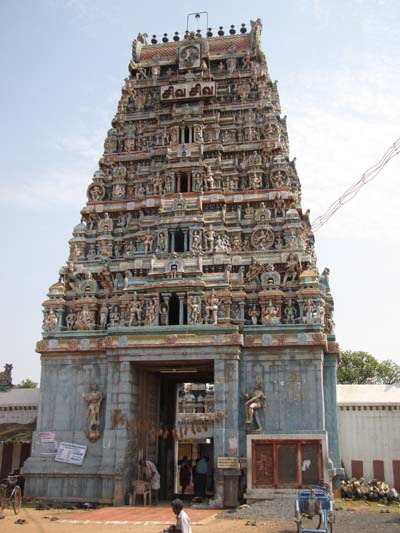|
Once inside, you could well be forgiven for thinking it to be an ancient temple in the Thanjavur area. Because the ambience is very much Chola in its architecture, sculpture and inscriptions on the walls and pillars. But it is a temple in Chennai, situated in one of the crowded residential suburbs in the western part of the city called Thirumullaivoyal, between Ambattur and Avadi, on NH 205 (the Madras-Tirupati Highway – MTH).
 The Masilamanishwarar temple, Thirumullaivoyal. |
The Masilamanishwarar temple is a renowned Siva shrine in northern Tamil Nadu, the area traditionally called Thondainadu or Thondaimandalam. It is one of the 32 temples praised in the Tevaram hymns. Sundaramurti Nayanar, of the Tevaram trio, who, according to historians, lived in the 9th Century A.D., visited the temple and sang hymns in praise of its deity.
However, it was in Chola times that the temple received great attention from royalty and layman alike. There are approximately a dozen inscriptions of the Chola era here. The earliest one, discovered on a slab on the floor of a mantapa, is in 19 short lines in Tamil and is clearly dated 961 A.D. The next is dated 984 A.D. and records a donation to the temple by Sembiyan Madevi, the illustrious Chola queen, wife of Emperor Gandaraditya and mother of Emperor Uttama Chola. If many a temple stands tall in Tamil Nadu today it is because she converted perishable brick monuments to stone ones. One particularly ‘precious’ inscription of the reign of Rajendra Chola I, the creator of the grand Chola capital, Gangaikondacholapuram, records a donation to the shrine of 44 manikkam (rubies), eight maragatam (sapphire), 32 vairam (diamonds) and 21 muthu (pearls) and five kalanju (a specific weight) of gold!
Many of these inscriptions reveal that the area was a Chola township, as the Ur, or the administrative body of the town, is mentioned. Geographically, the area was part of the ancient territorial sub-division called Puzhal-kottam, again a part of Jayankonda Chola Mandalam, as was nearby Ambattur, mentioned by the same name in thousand-year-old records. There are some lithic records of the later Pandyas of the 13th Century A.D., who eclipsed the might of the Cholas. Many inscriptions of the Vijayanagara rulers of the 15th Century and later are also to be found here.
It is surprising but, more so, heartening to see many of the ancient epigraphs intact, despite the many renovations that have taken place over the years. How you wish this could be true of so many other ancient temples in and around Chennai! The inscriptions along the base of the main sanctum have been very neatly and painstakingly etched, revealing the patience and talent of the anonymous scribes. It is noteworthy that the inscriptions of the temple were copied by epigraphists of the Archaeological Survey of India (ASI) and published as early as 1904.
The architecture of the main sanctum is special. Most people who visit it are unaware that the shape of this structure is apsidal, rather rare to see. Gajaprishta (back of an elephant) is the Sanskrit word used in architectural parlance to describe such shrines with rounded rear sides. Yet another feature here is two pillars, each of a single piece of wood of the erukku tree (Calotropis gigantea), on either side of the doorway to the principal sanctum. An even more interesting and eye-catching aspect is that, of the two Nandis facing the main shrine, the one in the outer courtyard faces not towards, but away from the deity! This is associated with the legend of the temple. The shrine of Goddess Kodividai Nayaki is next to the one for Siva.
The tall gopuram adorning the entrance to the temple, and visible from afar, has fine stucco sculptures of themes from Saivite mythology on it. It faces south, a rather rare phenomenon. In Chola times, it is very likely, the temple did not have such an entranceway, as the architectural features of the gopuram point to it having been constructed in the Vijayanagar style. A few yards in front is a multi-pillar mantapa, also of Vijayanagara vintage, but very badly maintained, although the premises of the main temple are spick and span. Carvings of gods and goddesses, clowns and jesters, saints and yogis, plants and animals vie for space on the pillars of this pavilion. These centuries-old sculptures, especially the ones at eye-level, are discoloured as they have grease and paint on them. A few are damaged. Some of the floral designs on the granite ceiling have been painted in gaudy colours. Oh, how we mutilate our treasures!
In a bid to safeguard our flora, many plants and trees have traditionally been assigned to be sacred to particular temples. The mullai (a variety of jasmine) plant is the sacred tree (sthala-vriksha) of the Masilamanishwarar temple. Apart from its flowers being used in worship in the temple, the plant has many medicinal properties. Likewise, the ancients sought to construct water-bodies in or outside temples which served not only ritual purposes, but also facilitated water harvesting. The huge tank of the temple has served this dual role for centuries.
The residents of Thirumullaivoyal have every right and reason to be proud of the area they are living in. But, have they, like people in other historic places in Chennai, been informed of their priceless heritage?
|